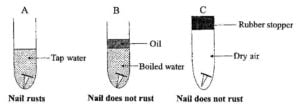BECE Past Questions & Answers – 2009 (SCIENCE)
April2009
SCIENCE2
1¼hours
ESSAY
[75marks]
This paper is in two sections, A and B
AnswerQuestion1in Section A and any other three questions in Section B. Credit will be given for clarity of expression and orderly presentation of material
SECTION A
[30 marks]
AnswerallofQuestion1
1. (a)In an experiment, four nails 1, 2, 3 and4 are fixed with candle wax onto a metal bar and one end of the bar is heated by means of boiling water as shown in the diagram below

A, B, C, D are thermometers inserted in holes along the bar to measure the temperatures at the various points.
(i) What is the temperature of the boiling water?
(ii) State the observations that will be made about nails 1, 2, 3 and 4
(iii) State the observations that will be made about the temperatures recorded by thermometers A, B, C and D.
(iv) What mode of heat transfer is demonstrated in the experiment
(v) State one effect of heat that is associated with the experiment
(vi) State the aim of the experiment
[10 marks]
(b) In an experiment, a student took three iron nails and cleaned their surfaces dry and placed them in three separate test tubes in set-ups A, B and C as shown in the diagram.

After three days the nail in set-up A was found to have rusted while the nails in set-ups B and C did not.
Answer the following questions:
(i) Why was the water inset-up B boiled?
(ii) Explain the function of the oil on top of the water in set-up B. (iii) State the purpose of the rubber stopper in set-up C
(iv) Why did the nail in set-up A rust? (v) Suggest an aim for the experiment.
(vi) From the experiment, explain why oil or grease is applied on the surface of a metal to prevent
rusting. [10 marks]
(c) In an experiment the following activities were carried out on two green leaves A and B.
Leaf A was from a plant placed in the sunlight for sometime while leaf B was from a plant placed in a dark cupboard for24 hours.
Activity
I. Leaves dipped in boiling water for 1 minute
II. Leaves dipped in warm alcohol
III. Leaves washed in cold water
IV. Leaves dipped into iodine solution
After dipping in the iodine solution, it was observed that leaf A changed colour while leaf B did not change colour.
Answer the following questions:
(i) Explain why each of the activities I,II,III and IV was carried out. (ii) Statethe colour change of leaf A
(iii) Explain why leaf A changed colour but leaf B did not.
(iv) Suggest an aim for the experiment. [10 marks]
SECTION B
[45 marks]
Answer any three questions from this section
2. (a) Explain each of the following observations in nature:
(i) In the depths of the ocean where it is always dark,there are no green plants.
(ii) On an island where there areno insects and birds,the pawpaw plant produces onlyflowers but no fruits [6 marks]
(b) Describe how soil is formed. [4 marks]
(c) (i) State the laws of reflection
(ii) Draw a labelled diagram to show the reflection of light on a plane mirror [5 marks]
3. (a) A child is found not to be able to see at night
(i) What deficiency disease may the child be suffering from? (ii) What food nutrient is the child lacking?
(iii) List two sources of food substances that can provide the nutrient the child lacks.
[4 marks]
(b) (i) What is an atom?
(ii) Name the components of an atom which determines each of the following quantities.
(α) mass of an atom
(β) charge of an atom
(iii) Why is an atom electrically neutral? [5 marks]
(c) (i) What is friction?
(ii) Give two bad effects of friction.
(iii) Give two situations where friction is an advantage
[6 marks]
4. (a) (i) Explain heredity
(ii) Give two examples of heredity characters
[5 marks]
(b) Explain whether each of the following processes is a chemical change or a physical change:
(i) Rusting;
(ii) (iii) (iv) Burning; Filtration;
Expansion of copper
[4 marks]
(c)
(i) (ii) (iii)
What is a simple machine?
Name two types of simple machines
Explain why the efficiency of a machine cannot be equal to 100%
[6 marks]
5. (a) Study the organisms listed below: Earthworm;
Sheep; Cassava plant; Grasshopper; Man;
Hen.
Draw a food chain using four of the organisms [4 marks]
(b) (i) Name four types of forces apart from friction.
(ii) Give three effects of a force
[7 marks]
(c) A certain pupil in a classroom can see clearly on the blackboard only when he sits at the front. (i) State the eye defect the child is suffering from.
(ii) Explain why the child is unable to see when he is far from the blackboard.
(iii) How can the defect be corrected?
[4 marks]
CLICK TO VIEW ANSWERS TO PART 2
SCIENCE2
SOLUTIONS
ESSAY
1. (a) (i) Temperature = 100°C or212°For 373K
(ii) Observations (Nails)
Nails 1, 2, 3 and 4 will drop off one after the other
– Nail1 drops first, nail 2 second, nail3 third andnail4fourth
(iii) Observations(Thermometers)
The readings of Thermometers A,B, C and D will increase progressively till they reach
100°C
– Thermometer A reaches 100°C first, B second,C third and D fourth
(iv) Mode of heat transfer – Conduction
(v) Effects of heat
Causes increase in temperature(as shown by the thermometer readings)
Causes change in state (candle wax melts– changes from solid to liquid)
(vi) Aim of experiment
To show that metals are good conductors of heat
To show that heat travels through metals
(b) (i) Why water inset-upBwas boiled
To remove dissolved air /oxygen from the water
(ii) The function of the oil on top of the water inset-up B
To prevent air(hence, oxygen) from entering/getting dissolved in the water
(iii) The purpose of the rubber stopper inset- up C
To prevent water particles or vapour or moisture from entering and contacting the nail
(v) Aim for the experiment
To show that moisture/ water and oxygen/ air are necessary for rusting to occur.
(vi) Why grease is applied on metals to prevent rusting
To prevent moisture and air, which contains oxygen, from getting into contact with the metal, since metals containing iron will rust in the presence of air and moisture.
(c) (i) Why each activity was carried out
I – to kill the plant cells or stop the process of photosynthesis
II – remove the green pigment (chlorophyll)
III – to wash away the alcohol and soften the leaf
IV – to test for starch in the leaf
(ii) Colour change of leaf A
From cream /pale yellow / light brown to blue-black
(iii) The blue-black colouration indicates thepresenceof starch, which means that photosynthesis occurred inleafA to produce starch.
Leaf B did not change in colour because photosynthesis did not occur, and hence, no starch was produced.
2. (a) (i) Reasons for no green plants in the dark ocean depths
No light reaches there, hence no photosynthesis takes place.
(ii)
Reasons for no fruits on pawpaw plant,where there are no insects and birds
Since there are no agents of pollination, no pollination takes place; hence, no fertilization
takes place.As aresult, no fruits are produced.
(b) How soil is formed:
Soil is formed from the disintegration/ breakdown/ weathering of rocks.The broken down rock particles combine with water, decayed organic matter,air and micro organisms to form soil
(c) (i) Laws of reflection
The angle of incidence is equal to the angle of reflection
The incident ray, the reflected ray and the normal,at the point of incidence,all lie in the same plane
(ii) Labelled diagram
i = angle of incidence, r = angleof reflection
3. (a) (i) Deficiency disease: Night blindness
(ii)
Food nutrient:
Vitamin A
(iii)
Foodsources:
Milk, butter, cheese,egg yolk, liver,palmoil, tomatoes, carrots, lettuce,cod-liver oil,
(b) (i) Atom
• The smallest particle of a substance that can take part in a chemical reaction
• The smallest portion into which an element can be divided and still retain its properties
(ii) Components of atom that determine
(α) mass ofatom: protons and neutrons
(β) charge of atom: protons and electrons
(iii) Why an atom is electricallyneutral:
Thenumbers of protons and electronsare equal.Thepositivelycharged protons neutralize the negativelychargedelectrons, hence, makingthe atomelectricallyneutral.
(c) (i) Friction is
The force that opposes the relative sliding motion of two bodies in contact
Or:
The resistance encountered by an object moving relative to another object with which it is
in contact
(ii)
Bad effects of friction
Reduces the efficiency of machines
Causes wear and tear
Causes loss of energy through heat generation
Slows down sliding motion of a body
(iii)
Situations where friction is an advantage
Enables walking, running, etc without slipping
Enables vehicles to brake effectively
Enables birds to perch on trees without falling
Enable wheels to roll on a surface
Enables our hands to hold items
4.
(a)
(i)
Heredity
The passing on of genetic factors from parents to children through genes:
Or: the transfer of genetically controlled characteristics from one generation to the next in living organisms
(ii)
Examples
Intelligence, shape of nose, height, colour of eyes,etc
(b) Explanationofwhetherchemical orphysical change:
(i) Rusting – Chemical change; because a new substance is formed and the change is irreversible
(ii) Burning – Chemical change; because a new substance is formed and the change is irreversible
(iii) Filtration – Physical change; because no new substance is formed and the change is reversible
5.
Gravitational, tensional,centripetal, centrifugal,magnetic, electrostatic, upthrust, cohesive, adhesive
(ii) Effects ofa force
• Can cause a moving body to come to rest (stop moving)
• Can cause a body at rest to move
• Can cause a moving body to accelerate
• Can cause a moving body to decelerate
• Can change the direction of a moving body
• Can change the shape of a body
(c) (i) The eye defect: short sightedness or myopia
(ii)
Explanation
Light rays from a distant object are focused infront of the retina, due to the eye lens being thicker than normal or eye ball being too long. Hence the brain does not receive the correct information for interpretation and so the child is unable to see.
(iii) Howthedefect can be corrected: Bythe use of aconcaveordiverginglens





